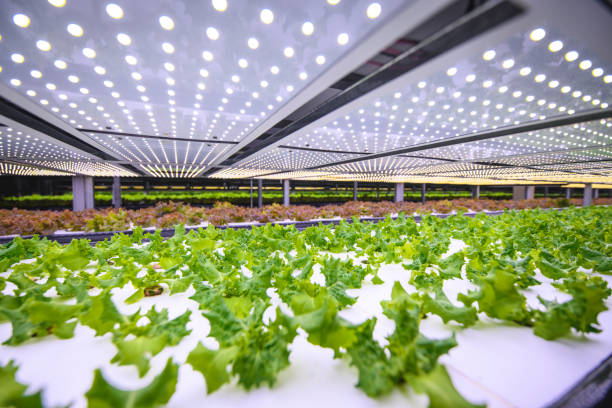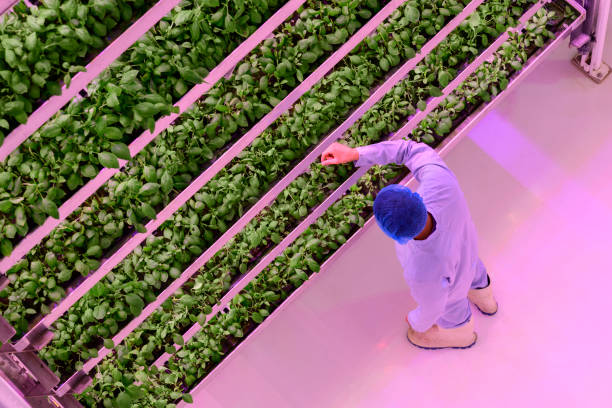What is Vertical Farming
Table of Contain
- What is Vertical Farming
- Which Crops are Suitable for Vertical Farming
- Which Country are leading in Vertical farming & Why
- why Vertical farming is future
- What important points need to think before starting
- Why Gulf Country should try for such type of Farming

Vertical farming is a method of growing crops in vertically stacked layers using controlled environment agriculture (CEA) technology. It is a type of urban agriculture that is practiced in buildings, warehouses, or other indoor spaces, using artificial lighting and climate control systems to optimize growing conditions for plants.
In a vertical farm, crops are grown in trays or towers that are stacked on top of each other, allowing for maximum use of space. The plants are grown using hydroponic or aeroponic systems, which provide the necessary nutrients and water to the plants without soil.
Vertical farming has several advantages over traditional farming methods. It allows for year-round production of crops, regardless of weather conditions or seasonal changes. It also uses less water and land than traditional farming, and can be located in urban areas, reducing transportation costs and carbon emissions associated with food distribution.
Another benefit of vertical farming is that it can produce crops without the use of pesticides or herbicides, reducing the risk of contamination and promoting food safety.
However, vertical farming also has some challenges and limitations, such as the high cost of setting up and maintaining the necessary technology and infrastructure, as well as the need for a reliable and affordable source of energy to power the artificial lighting and climate control systems.
Overall, vertical farming is a promising approach to sustainable food production that has the potential to increase food security, reduce environmental impact, and provide fresh and healthy produce to urban populations
crops are suitable for vertical farming, including:
- Leafy Greens: These crops, such as lettuce, spinach, and kale, are popular in vertical farming because they are fast-growing and do not require a lot of space or light to grow.
- Herbs: Herbs like basil, mint, and cilantro are also popular in vertical farming due to their quick growth and high demand in urban markets.
- Strawberries: This fruit is well-suited for vertical farming because it can be grown in towers or hanging baskets, allowing for maximum use of space.
- Tomatoes: Tomatoes can be grown vertically using trellises or stakes, which supports the plant and allows for higher yields in a smaller space.
- Microgreens: These small, delicate greens are popular in high-end restaurants and are well-suited for vertical farming due to their quick growth and high market value.
The crops that are best suited for vertical farming are those that can be grown efficiently in a controlled environment with artificial lighting, hydroponic or aeroponic growing systems, and climate control. These crops tend to have short growth cycles and high demand in urban markets, making them profitable for vertical farming operations. Additionally, crops that can be harvested multiple times, such as leafy greens, can provide a steady supply of fresh produce throughout the year. Overall, the best crops for vertical farming are those that can be grown efficiently, sustainably, and profitably in a controlled indoor environment
Which Country are leading in Vertical farming & Why
Several countries are leading in vertical farming, each with its unique strengths and advantages. Some of the leading countries in vertical farming include:
- Japan: Japan is one of the pioneers in vertical farming and has been using the technology since the 1990s. The country has limited arable land, and vertical farming has helped it to maximize food production in urban areas. Japan has developed several innovative technologies for vertical farming, including advanced hydroponic systems, LED lighting, and robotic automation.
- United States: The United States has a thriving vertical farming industry, with several successful startups and established companies. The country has a large market for fresh produce, and vertical farming has helped to reduce transportation costs and carbon emissions associated with food distribution. The United States is also home to some of the leading research institutions and universities that are developing new technologies and practices for vertical farming.
- Singapore: Singapore is a small island nation with limited land for agriculture. Vertical farming has helped the country to become more self-sufficient in food production and reduce its reliance on food imports. The country has developed several innovative vertical farming systems, including the world’s first commercial-scale rooftop farm and vertical fish farms.
- Netherlands: The Netherlands is a world leader in agricultural innovation and has been using vertical farming technology to grow crops in urban areas. The country has developed several advanced technologies for vertical farming, including automated growing systems, energy-efficient LED lighting, and advanced climate control systems.
- China: China has a large population and limited arable land, making vertical farming an attractive option for urban agriculture. The country has several large vertical farming operations that are producing high-quality crops for local markets. China is also investing heavily in research and development of new technologies and practices for vertical farming.
Overall, the countries that are leading in vertical farming are those that have limited land for agriculture, high demand for fresh produce, and a strong focus on innovation and technology. These countries are leveraging vertical farming to increase food production, reduce environmental impact, and create new opportunities for sustainable agriculture in urban areas.
why Vertical farming is future

Vertical farming is considered the future of agriculture because it offers a more sustainable and efficient way to produce food in urban areas. Here are some of the reasons why:
- Space-saving: With the world’s population growing rapidly, the demand for food is also increasing. Vertical farming allows us to grow crops in a smaller area by stacking layers of crops vertically, making it possible to produce more food in less space.
- Water-saving: Vertical farming uses a closed-loop irrigation system, which means that water is recycled and reused, reducing the amount of water needed to grow crops.
- Energy-efficient: Vertical farms use energy-efficient LED lighting, which means that they require less energy than traditional farming methods.
- Year-round production: Vertical farms can produce crops year-round, regardless of weather conditions or seasonal changes, ensuring a steady supply of fresh produce.
- Reduced environmental impact: Vertical farming reduces the need for pesticides, herbicides, and fertilizers, which can be harmful to the environment. Additionally, since vertical farms are often located in urban areas, there is less transportation needed to bring food from the farm to the consumer, reducing carbon emissions.
- Local production: Vertical farms can be located in or near urban areas, which means that food can be produced and consumed locally, reducing the carbon footprint associated with transporting food long distances.
Overall, vertical farming offers a more sustainable, efficient, and environmentally friendly way to produce food in urban areas, which is why it is seen as the future of agriculture.
What important points need to think before starting
Starting a vertical farm is a complex process that requires careful planning and consideration. Here are some important points to think about before starting:
- Location: The location of your vertical farm is crucial to its success. It should be easily accessible, have sufficient space, and be near your target market.
- Capital: Vertical farming requires a significant initial investment, so you need to ensure that you have enough capital to cover the startup costs, including the cost of equipment, land, and utilities.
- Market demand: You need to do thorough research to determine the demand for the crops you plan to grow. You should also consider the pricing of your crops and whether you can compete with other growers.
- Crop selection: Selecting the right crops for your vertical farm is important. You need to consider the growing conditions, market demand, and profitability of the crops.
- Technology: The success of your vertical farm depends on the technology you use. You should consider the latest technologies and equipment to ensure that your farm is efficient and produces high-quality crops.
- Sustainability: You should consider the sustainability of your vertical farm, including the use of renewable energy, water conservation, and the use of organic and sustainable growing practices.
- Regulations: Vertical farming is a relatively new industry, and there may be regulations and permits required for your operation. You need to ensure that you are compliant with all regulations and obtain any necessary permits before starting your farm.
By considering these important points, you can increase your chances of success and ensure that your vertical farm is profitable and sustainable.
Why Gulf Country should try for such type of Farming
Gulf countries face several challenges when it comes to agriculture, including arid climates, limited water resources, and a lack of arable land. Vertical farming can help Gulf countries overcome these challenges and become more self-sufficient in terms of food production. Here are some reasons why:
- Water conservation: Gulf countries face severe water shortages, and traditional farming methods require a significant amount of water. Vertical farming uses a closed-loop irrigation system that recycles water, reducing water usage by up to 90%. This makes it a more water-efficient option for food production in arid climates.
- Land conservation: Land is a scarce resource in Gulf countries, and vertical farming allows for more efficient use of space by stacking crops vertically. This means that more food can be produced in a smaller area, making it a more land-efficient option for food production.
- Year-round production: Traditional farming is limited by seasonal changes and weather conditions, but vertical farming allows for year-round production, which is especially important in Gulf countries where extreme temperatures and sandstorms can make outdoor farming challenging.
- Local production: Gulf countries import a significant amount of their food, which can be expensive and contribute to carbon emissions. Vertical farming allows for local food production, reducing the need for imports and transportation.
- Sustainable food production: Vertical farming can be done using organic and sustainable growing practices, making it a more environmentally friendly option for food production.
Overall, vertical farming can help Gulf countries overcome the challenges of traditional agriculture and become more self-sufficient in terms of food production. It is a sustainable and efficient option for food production that can help address issues related to water scarcity, land availability, and food security.



Pingback: Dragon fruit also known as ‘kamalam’ and ‘Pitaya’ in India - Fresh To Fit